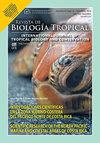Heat loss or heat uptake? Skin temperature in Antillean manatees (Trichechus manatus manatus, Sirenia: Trichechidae) in Belize
IF 0.6
4区 生物学
Q4 BIOLOGY
引用次数: 0
Abstract
Introduction: The two subspecies of the West Indian manatee (Trichechus manatus), Florida manatees (T. m. latirostris) and Antillean manatees (T. m. manatus), face different environmental challenges. While Florida manatees have to cope with winter water temperatures below their lower critical temperature of ~ 20 °C and air temperatures below freezing, Antillean manatees live in year-round warm Caribbean waters. Sirenians lack effective thermal insulation and have limited capability of controlling peripheral heat loss. Although severe cold related health issues and mortality are primarily known in Florida manatees, it can be assumed that Antillean manatees and other extant sirenians share the cold-sensitivity, but hardly ever experience it. Contrarily, during summer, Antillean manatees may face the opposite form of thermal stress by being exposed to water temperatures close to their body temperature. However, the upper critical temperature of manatees is not known. Objective: To improve understanding of the impact of high ambient temperatures on manatee physiology. Methods: We measured skin temperature in six Antillean manatees in two different habitats in Belize, and compared the results to skin temperatures measured in two captive Florida manatees. Results: We found a similar temperature distribution pattern over the body surface in both subspecies, but significantly higher temperatures and larger temperature ranges among measuring points in Antillean manatees as compared to Florida manatees. In one Antillean manatee, skin temperature was consistently lower than ambient water temperature by up to 2.5 °C. This implies potential heat uptake from the environment, in contrast to the heat loss experienced by Florida manatees at low water temperatures, apparent in skin temperatures above ambient water temperature. Conclusions: Our findings suggest that heat stress may be a more likely risk for manatees in warm tropical waters. Despite the small sample size, our results present important findings towards understanding thermal tolerance and impact of high ambient temperatures on manatee physiology.热损失还是热吸收?伯利兹安的列斯海牛(trichecchus manatus manatus, Sirenia:毛海牛科)的皮肤温度
西印度海牛(trichecchus manatus)的两个亚种,佛罗里达海牛(t.m. latirostris)和安的列斯海牛(t.m. manatus)面临着不同的环境挑战。佛罗里达海牛必须应对冬季水温低于其最低临界温度~ 20°C和气温低于冰点,安的列斯海牛全年生活在温暖的加勒比海水域。sirenes缺乏有效的隔热,控制外围热损失的能力有限。虽然人们主要知道佛罗里达海牛有严重的与寒冷有关的健康问题和死亡率,但可以假设安的列斯海牛和其他现存的海牛都对寒冷敏感,但几乎从未经历过。相反,在夏季,安的列斯海牛可能会面临相反形式的热应激,因为它们暴露在接近体温的水温中。然而,海牛的最高临界温度尚不清楚。
目的:提高对高环境温度对海牛生理影响的认识。方法:我们测量了伯利兹两种不同栖息地的6只安的列斯海牛的皮肤温度,并将结果与两只圈养的佛罗里达海牛的皮肤温度进行了比较。结果:我们发现两个亚种的体表温度分布模式相似,但与佛罗里达海牛相比,安的列斯海牛在测量点之间的温度和温度范围明显更高。在一只安的列斯海牛身上,皮肤温度一直比周围水温低2.5°C。这意味着从环境中吸收潜在的热量,与佛罗里达海牛在低水温下经历的热量损失形成对比,皮肤温度高于环境水温。结论:我们的研究结果表明,热应激可能是海牛在温暖的热带水域更可能面临的风险。尽管样本量小,但我们的结果对于理解热耐受性和高环境温度对海牛生理的影响提供了重要的发现。
本文章由计算机程序翻译,如有差异,请以英文原文为准。
求助全文
约1分钟内获得全文
求助全文
来源期刊

Revista De Biologia Tropical
生物-生物学
CiteScore
1.80
自引率
0.00%
发文量
23
审稿时长
4-8 weeks
期刊介绍:
The Revista de Biología Tropical / International Journal of Tropical Biology and Conservation is a mainstream scientific journal published since 1953 and covered by Web of Science; Science Citation Index; Current Contents; Google Scholar; Scopus, SciELO and nearly 50 additional indices.
A double blind system guarantees you a fair evaluation, and our world class editorial and scientific boards provides a first decision in three working days. The journal is Full Open Access and is widely read where your article can have the highest real impact.
Since its beginning in 1953, the Revista follows these principles: objective and independent evaluation of all manuscripts; transparency in all processes; ethical use of procedures, data, specimens and subjects; fair treatment of all parties; and absolute predominance of scientific rigor over any other aspect.
 求助内容:
求助内容: 应助结果提醒方式:
应助结果提醒方式:


